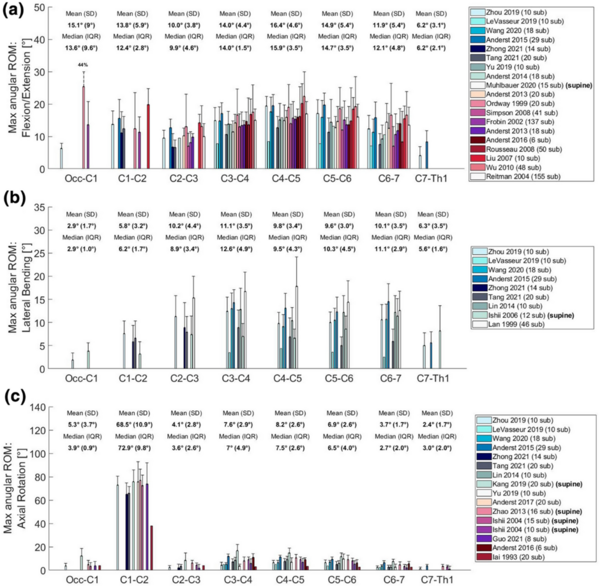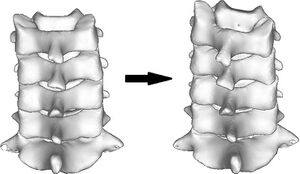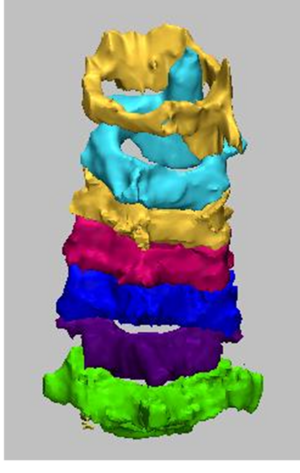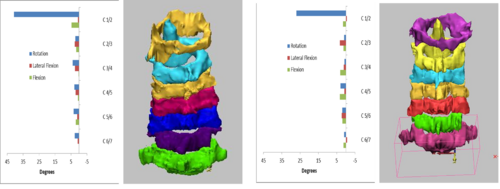Kinematics of the Cervical Spine
This article or area is currently under construction and may only be partially complete. Please come back soon to see the finished work! (25/01/2024)
Introduction[edit | edit source]
The cervical spine is the most mobile region of the spine and enables the head with its sensory organs of sight, hearing and smell to be oriented independently from the trunk. The kinematics of the cervical spine are complex - seven vertebrae as well as articulations with the occiput and upper thoracic spine, each with different axes of movement which can combine in a multitude of ways. As a result, an intended orientation of the head can be achieved in a number of ways.
Movements of the cervical spine are 1) constrained by the anatomy of motion segments and longer connective structures that span multiple segments and 2) controlled by the neuromuscular system both of which are discussed elsewhere. This section will consider active movement (AROM) of the neck and of the individual motion segments that make up the neck from a kinematics perspective - that is the movements will be discussed without considering how the movements are constrained or produced.
Although this section will consider the cervical spine, it is important to recognize that the neck is connected to the rest of the body. Movement of the head includes movement of the thoracic as well as the cervical spine. The video below shows a fluoroscopy of cervical rotation taken from a 45 degree angle with the shoulders held stationaly. Note the amount of movement that occurs at T1 (the lowest spinous process that is visible)
Cardinal Directions[edit | edit source]
Positions and movements of the body are generally described in relation to three axes of movement and three cardinal planes. In the spine, and particularly the cervical spine, movements do not occur simply in one plane or around one axis, but rather include translational movements as well as coupled (also referred to as conjoint or combined movements) movements around other axes [1] .
Active Movements[edit | edit source]
Active cervical rotation usually results in a small amount of coupled lateral flexion and flexion/extension with the coupled movements of lateral flexion are usually greater than those in flexion/extension. Different studies have found that the average lateral flexion is either ipsilateral [2] or the contralateral [1] to the direction of rotation. The movement trace below is one example others are available in published articles. [2]
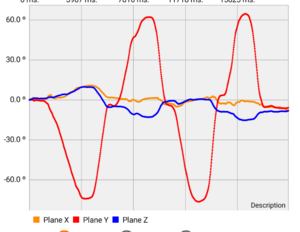
When considering the observed coupled movements Salem, et. al. (2) observed:
Mean coupled lateral flexion was −2.3 ± 10.7° occurring in the same direction as the rotation. However, the standard deviation is important, indicating that several subjects performed a lateral flexion in the opposite direction to rotation (5 of 20 subjects).
Not only is this coupling not consistent between individuals, but it also varies with repeated movements for a given individual. How someone is instructed to move may also change the pattern. For example, “turn your chin towards your left shoulder” is likely to result in a different pattern of movement than “turn to see as far as you can behind your left shoulder”. Some translation of the head also occurs which perhaps most notably is a translation towards the side of rotation.
Segmental Movement[edit | edit source]
Contributions of individual motion segments of the cervical spine to full range AROM[edit | edit source]
The amount of movement in of motion segments (movement between individual pairs of vertebrae) varies between levels as shown below. Note that these ranges are for full axis movements from the limit in one direction to the limit in the opposite direction.
The range of rotation of C1-C2 makes up approximately half of the total AROM range. The other motion segments from C2 – C7 generally have less than 11 degrees of rotation with even less at O – C1. The segmental movements in flexion/extension are fairly similar across the region (10.0 to 16.4°) except for less movement occurring in C7-T1. Lateral flexion is also fairly consistent at around 10 degrees per level from C2 to C7 but with less movement between the occiput and C2.
For one-sided movements, the mean lateral flexion between C2 and C7 is about five degrees in each direction while the mean rotation from C3 to C7 ranges from two to four degrees.
An aside[edit | edit source]
The descriptions of the averages above for both coupled and segmental movement patterns however have limitations as suggested by the English polymath and statistician Frances Galton (1822 – 1911) who so eloquently stated:
“It is difficult to understand why statisticians commonly limit their inquiries to averages, and do not revel in more comprehensive views. Their souls seem as dull to the charm of variety as that of the native of one of our flat English counties, whose retrospect of Switzerland was that, if its mountains could be thrown into its lakes, two nuisances would be got rid of at once.”
Axes of Movement[edit | edit source]
The structure of the facets and discs determine the movements that are possible between each pair of vertebrae. During AROM, the facets of the cervical spine mostly remain in contact [3]. There are some exceptions to this. For example there is often some separation of the facet surfaces in the upper cervical spine during rotation that enables the head to remain level.
Because of these structures, the segmental movements for C1 – T1 do not occur along the three cardinal planes but can be better described as occurring around two perpendicular axes. [4] Flexion/Extension occur around one transverse axis which passes through the vertebral body of the lower vertebra in the motion segment. A second axis is perpendicular to the first and is approximately normal to the plane of the facets. Just as the plane of the facets is different for different levels, so too is the orientation of the second axis. This second axis is more vertical in the upper cervical spine and moves closer to an AP direction for the lower motion segments. Importantly, the axes are not fixed, and the instantaneous centres of rotation (the location of the axis of movement) move somewhat during active movement.
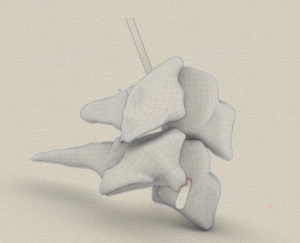
Coupled Movements – Segmental[edit | edit source]
There is usually an ipsilateral lateral flexion in the lower cervical motion segments during active rotation. An image of the segments of the lower cervical spine at the end of range of rotation is shown below. This image shows the most common pattern that occurs at the limit of rotation. Each of the motion segments from C3 to C7 have the facets moving down on the right and up on the left to create a position of C3 which is both rotated and laterally flexed to the right. Image from: https://doi.org/10.1371/journal.pone.0215357.g005 creative commons license
In this position, as well as being rotated, C3 is tilted (laterally flexed) to the ipsilateral side. The upper cervical spine then needs to do some adjusting to keep the head level and facing to the right. The image below [5] shows one example of how this can be done. In addition to coupled movements around other than the primary axis of the upper cervical spine these strategies result in translation. Notice how C2 including the dens in this position is translated to the right.
Just as with movement of the whole cervical spine, the pattern of segmental movements are highly variable both between and within individuals. Observations that highlight this variability include:
- The direction and extent of coupled movements changes with slight differences the active movement such as keeping the head level in rotation.[6]
- The limiting factor for range of movement is not usually segmental mobility, but extra-segmental factors such as ligaments spanning multiple segments. [4] The contribution of individual segments is therefore indeterminant meaning that multiple combinations can reach the same head position.
- The end-of-range and through-range contributions of motion segments in an individual are not consistent with repeated movements. [7]
- Most, if not all motion segments exhibit paradoxical (anti-directional) movement during active movement. [8] In other words, at some times during a movement such as flexion, most motion segments reverse their movement and move towards extension.
- Sequencing of segmental movement is neither top to bottom nor bottom to top. Rather the sequencing does not follow a specific order and varies both between and within individuals. [9]
Effects of pathology
It would seem reasonable to think that if there is limitation of movement at a particular motion segment that there would be a corresponding limitation of active movement. Unfortunately, it is not that simple. There is a reduction in AROM in people neck pain. A systematic review found the sum of all movement decreased by approximately 90 degrees or 20-25%. [10] There is also some alteration in segmental movement in people with neck pain particularly in lower cervical segments where degenerative changes are more common.[11] Since these studies do not indicate the location of patient’s symptoms, there is no way of knowing whether there is a relationship between the location of symptoms and limitations of mobility.
There are two situations where a single motion segment is impaired and the distribution of segmental mobility is known. Single level fusion and a case study of cervical radiculopathy.
Single level fusions produce minimal reduction in overall AROM – less than the movement that would have previously been present at the fused level. The loss of movement in the fused motion segment is compensated for by alterations in multiple planes of movement not just at adjacent levels but also throughout the region. [12][13]
There is one case study where data is available on segmental movement before and during symptoms of a C6 cervical radiculopathy. [5] The image below shows the segmental movements before (left) and in the presence of (right) a radiculopathy. Movement at each level in each of the three cardinal axes of movement are shown to the left of each image. In this instance, the total range of movement was limited by nearly 50% - far more than could be accounted for by a single low cervical level. The pattern of movement is altered with most axes of segmental movement reduced while some coupled movements are increased. Overall rotation was reduced by approximately 50%. The quantity as well as the pattern of segmental movement has altered across all levels. Note for example how in this example flexion has increased at both C3/4 and C4/5.
Presuming that a radiculopathy is a pathology that predominantly affects one motion segment, it appears that a painful limitation of movement in one motion segment can affect segmental movement through the whole region. This is not to suggest that all of the levels are inherently impaired, but rather that individuals probably don’t have sufficient motor control to be able to prevent a painful movement in one motion segment while allowing full movement in the other segments.
Clinical implications
The cervical spine is a complex system with multiple degrees of freedom. Both total movements of the cervical spine and the segmental contributions to those movements are highly variable. People can use various movement strategies to achieve similar movements and a limitation of movement in one motion segment could affect active movement in a variety of ways. Therefore the effect of a limitation of segmental mobility in a given direction is unlikely to have a predictable effect on the pattern of active range of movement. Similarly, a particular impairment of active movement is unlikely to predict the direction of a segmental limitation.
These findings call into question the idea that coupled movements occur in particular directions or that the selection of treatment techniques should be based on either the direction of impairments of active movement or on presumed biomechanical relationships such as Fryette's Laws of Spinal Motion
- ↑ 1.0 1.1 Kang J, Chen G, Zhai X, He X. In vivo three-dimensional kinematics of the cervical spine during maximal active head rotation. PLoS One. 2019;14(4):e0215357.
- ↑ 2.0 2.1 Salem W, Lenders C, Mathieu J, Hermanus N, Klein P. In vivo three-dimensional kinematics of the cervical spine during maximal axial rotation. Manual therapy. 2013.
- ↑ Malmstrom EM, Karlberg M, Fransson PA, Melander A, Magnusson M. Primary and Coupled Cervical Movements: The Effect of Age, Gender, and Body Mass Index. A 3-Dimensional Movement Analysis of a Population Without Symptoms of Neck Disorders. Spine. 2006;31(2):E44-E50.
- ↑ 4.0 4.1 Bogduk N, Mercer S. Biomechanics of the cervical spine. I: Normal kinematics. Clin Biomech. 2000;15(9):633-48
- ↑ 5.0 5.1 Evans KA, Tuttle NA. Alterations in 3D segmental kinematics in an asymptomatic individual who later developed an acute cervical radiculopathy: A case study. 2015.
- ↑ Muriuki MG, Havey RM, Blank KR, Patwardhan AG. Coupled rotation patterns in cervical spine axial rotation can change when the head is kept level. Journal of Biomechanics. 2024:111924.
- ↑ Wang X, Lindstroem R, Plocharski M, Østergaard LR, Graven-Nielsen T. Repeatability of Cervical Joint Flexion and Extension Within and Between Days. Journal of Manipulative & Physiological Therapeutics. 2018;41(1):10-8.
- ↑ Wang X, Lindstroem R, Plocharski M, Østergaaard LR, Graven-Nielsen T. Cervical flexion and extension includes anti-directional cervical joint motion in healthy adults. The Spine Journal. 2018;18(1):147-54.
- ↑ Guo R, Zhou C, Wang C, Tsai T-Y, Yu Y, Wang W, et al. In vivo primary and coupled segmental motions of the healthy female head-neck complex during dynamic head axial rotation. Journal of biomechanics. 2021;123:110513.
- ↑ Stenneberg MS, Rood M, de Bie R, Schmitt MA, Cattrysse E, Scholten-Peeters GG. To what degree does active cervical range of motion differ between patients with neck pain, patients with whiplash, and those without neck pain? A systematic review and meta-analysis. Archives of physical medicine and rehabilitation. 2017;98(7):1407-34.
- ↑ Nagamoto Y, Ishii T, Sakaura H, Iwasaki M, Moritomo H, Kashii M, et al. In vivo three-dimensional kinematics of the cervical spine during head rotation in patients with cervical spondylosis. Spine (Phila Pa 1976). 2011;36(10):778-83.
- ↑ Anderst WJ, Lee JY, Donaldson WF, 3rd, Kang JD. Six-degrees-of-freedom cervical spine range of motion during dynamic flexion-extension after single-level anterior arthrodesis: comparison with asymptomatic control subjects. J Bone Joint Surg Am. 2013;95(6):497-506.
- ↑ Schwab JS, DiAngelo DJ, Foley KT. Motion compensation associated with single-level cervical fusion: where does the lost motion go? Spine. 2006;31(21):2439-48.
